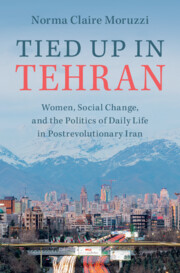Book contents
- Tied Up in Tehran
- Tied Up in Tehran
- Copyright page
- Contents
- Acknowledgments
- Tables
- Preface
- 1 Introduction: The Personal Is Political – How I Came to Write This Book
- 2 Tied Up in Tehran: A Metaphor
- 3 How Our Mothers Drive Us Crazy: Hospitality, Ritual, and the Burden of the Social
- 4 Food as a Social Relation: Sabzi and the Question of Household Skilled Labor
- 5 Elegy or The Rule of the Fathers: The Break with the Past
- 6 Democratic Intimacies: Jokes, Sex, and Ta’arof
- 7 Through the Looking Glass: Reflexive Cinema and Society in Postrevolutionary Iran
- 8 Women, Life, Freedom: One Movement out of Two Legacies
- 9 Being a Public Woman: Streets, Cars, Crimes, and the Shifting Calculus of Moral Accountability
- 10 Shopping for Shoes: Consumer Identity, Commodity Fetishism, and Gender as a Brand
- 11 We Are More Than One, When We Speak Together: Collective Art, Plural Possibilities, and the Horizon of Utopia
- 12 Coda: Thinking in Practice – Arendt, Foucault, and the Challenge of Freedom
- Bibliography
- Index
- References
Bibliography
Published online by Cambridge University Press: 28 September 2025
- Tied Up in Tehran
- Tied Up in Tehran
- Copyright page
- Contents
- Acknowledgments
- Tables
- Preface
- 1 Introduction: The Personal Is Political – How I Came to Write This Book
- 2 Tied Up in Tehran: A Metaphor
- 3 How Our Mothers Drive Us Crazy: Hospitality, Ritual, and the Burden of the Social
- 4 Food as a Social Relation: Sabzi and the Question of Household Skilled Labor
- 5 Elegy or The Rule of the Fathers: The Break with the Past
- 6 Democratic Intimacies: Jokes, Sex, and Ta’arof
- 7 Through the Looking Glass: Reflexive Cinema and Society in Postrevolutionary Iran
- 8 Women, Life, Freedom: One Movement out of Two Legacies
- 9 Being a Public Woman: Streets, Cars, Crimes, and the Shifting Calculus of Moral Accountability
- 10 Shopping for Shoes: Consumer Identity, Commodity Fetishism, and Gender as a Brand
- 11 We Are More Than One, When We Speak Together: Collective Art, Plural Possibilities, and the Horizon of Utopia
- 12 Coda: Thinking in Practice – Arendt, Foucault, and the Challenge of Freedom
- Bibliography
- Index
- References
Information
- Type
- Chapter
- Information
- Tied Up in TehranWomen, Social Change, and the Politics of Daily Life in Postrevolutionary Iran, pp. 331 - 352Publisher: Cambridge University PressPrint publication year: 2025
